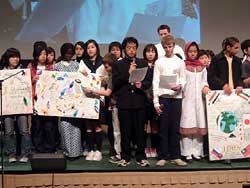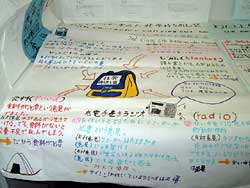|
KIDS IN ACTION Learning to Cope with Natural Disasters | ||||||||
About 500 students from Japan and 48 students from other countries, including two who lost family members in the Indian Ocean tsunami, gathered in Hyogo Prefecture to consider ways of minimizing damage from earthquakes and other catastrophes at the Natural Disaster Youth Summit from March 25 to 28. The summit coincided with the tenth anniversary of the Great Hanshin-Awaji Earthquake, which left more than 6,000 people dead after it struck the southern part of Hyogo Prefecture in January 1995. The event was sponsored by JEARN, the Japanese branch of the International Education and Resource Network (iEARN). With 20,000 schools in 109 countries, iEARN is the largest educational network in the world. It organizes a variety of online programs for students, including a collaboration on disaster prevention for schools in 13 countries, which got underway in September 2004 and culminated in the summit.
During the four days of the summit, students shared accommodations and were able to get to know each other and learn more about each other's cultures. On March 25 and 26 they built a playground in the National Akashi Strait Park, working together to put up a swing and a slide. On March 27 they visited the Disaster Reduction and Human Renovation Institution, which tells the story of the Great Hanshin-Awaji Earthquake and seeks to promote an understanding of the lessons from the tragedy. The students then attended a forum and heard about the experiences of Japan International Cooperation Agency team members who provided medical assistance in areas hit by the Sumatra earthquake and Indian Ocean tsunami in December 2004. After the talks, they split up into small groups and held discussions aimed at drawing up a written declaration for the summit. On the final day, the students gathered at the Awaji Yumebutai International Conference Center to give a poster presentation. Using words and colorful pictures, they expressed their own feelings on what they could do to reduce damage from natural disasters. They also announced the summit declaration, which stresses the importance of "Try to feel, try to learn, try to share." As the summit drew to a close, the kids exchanged e-mail addresses and assured each other that this event was just the start of an exchange that will continue even after their return home. Okamoto Kazuko, chairman of the summit's executive committee, said that JEARN would continue to organize projects that teach young people about dealing with natural disasters, because many people around the world are still not taught these important lessons. |

